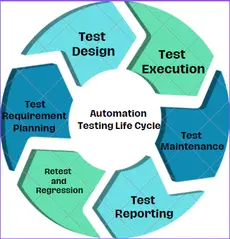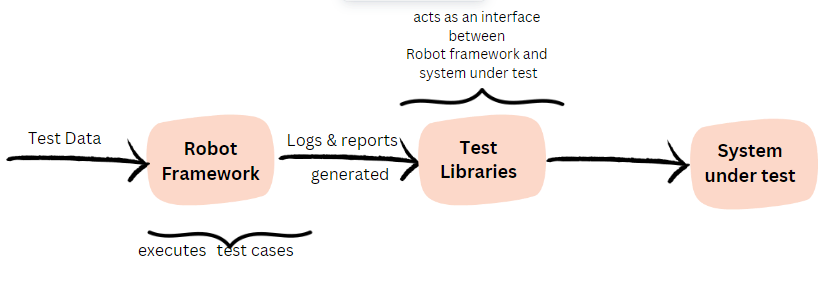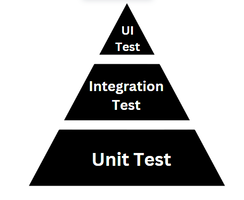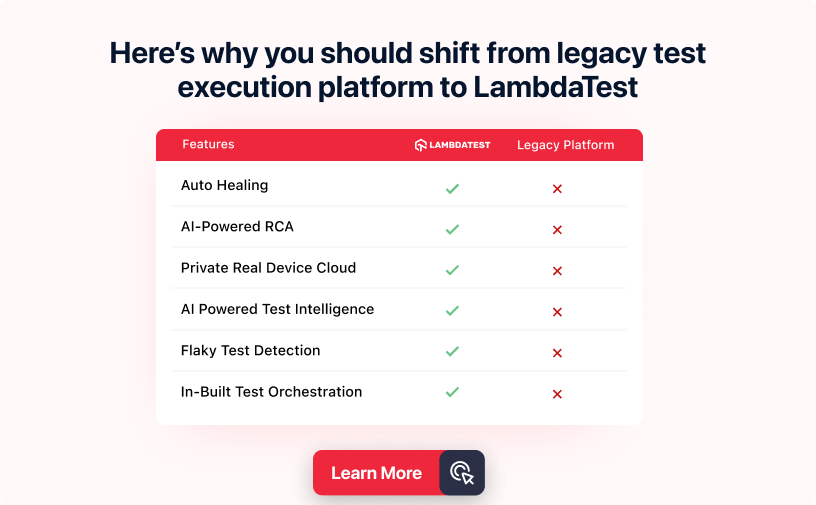AI-Powered Automation
Testing Cloud
Trusted by 2 Mn+ QAs & Devs to accelerate their release cycles

- Testing Basics
- Home
- /
- Learning Hub
- /
- Top 31 Automation Testing Interview Questions
- -
- Apr 24 2024
Top 31 Automation Testing Interview Questions
Explore the top 31 automation testing interview questions to prepare for your next job interview as a Software tester or QA.
- Share:
- Testing Framework Interview Questions
- Testing Types Interview Questions
- General Interview Questions
- Software Testing Interview Questions
- Manual Testing Interview Questions
- Automation Testing Interview Questions
- Agile Interview Questions
- CI/CD Interview Questions
- BDD Interview Questions
- Mobile Testing Interview Questions
- Software Engineering Interview Questions
- SDET Interview Questions
- Quality Assurance (QA) Interview Questions
- PWA Interview Questions
- iOS Interview Questions
- Linux Interview Questions and Answers
- Operating System Interview Questions
- Web Development Interview Questions
- Frontend Interview Questions
- Git interview Questions
- Scrum Master Interview Questions
- Data Structure Interview Questions
- SAP Interview Questions and Answers
- Salesforce Interview Questions and Answers
- CI/CD Tools Interview Questions
- Programming Languages Interview Questions
- Development Framework Interview Questions
- Automation Tool Interview Questions
OVERVIEW
Are you preparing for an automation testing interview? You've landed on the right page! With the help of our list of top 31 automation testing interview questions, you may polish your technical skills and get a deep insight into understanding what interviewers typically ask.
Whether you're a seasoned automation tester or a newcomer to the field, these questions will equip you with the essential knowledge to impress interviewers.
Automation Testing Interview Questions
Note : We have compiled all Automation Testing Interview Questions List for you in a template format. Feel free to comment on it. Check it out now!!
Interview Questions For Automation Testing
1. What is Automation Testing?
Automation testing is a software testing technique that uses automated scripts and testing tools to validate the software functionality and ensure it meets requirements before release. The primary goal of automation testing is to increase the efficiency, effectiveness, and test coverage while minimizing human errors.
2. What are the popular automation testing tools in the market?
Automation testing tool is a software application that automates the process of testing software applications. It allows testers to execute test cases automatically, eliminating manual testing and increasing testing efficiency and accuracy.
When selecting an automated testing tool, there are several factors to consider, such as your application, testing needs, and your team’s preferences. The popular automation testing tools in the market are:
- Selenium
- Appium
- JUnit
- TestNG
- Cucumber
- Robot Framework
3. How is Automation Testing different from Manual Testing?
| Aspect | Manual Testing | Automation Testing |
|---|---|---|
| Execution Process | Tests executed manually by human testers | Tests executed using automated scripts and tools |
| Speed and Efficiency | Relies on human speed and accuracy, can be slower | Faster and more efficient, especially for repetitive tests |
| Resource Dependency | Heavily relies on human testers, leading to scalability challenges and higher costs. | Reduces resource dependency on human testers, utilizing automated scripts. |
| Exploratory Testing | Well-suited for dynamic exploration, allowing testers to adapt in real-time. | Less effective due to its scripted nature, and better for repetitive scenarios. |
| Initial Setup and Maintenance | Minimal initial setup, may involve more documentation | Requires initial investment in script development and tool setup, regular maintenance |
| Test Coverage | Coverage may be limited due to time and resource constraints | Achieves broader test coverage, runs large numbers of test cases quickly |
4. Can automation testing replace manual testing?
No, automation testing cannot replace manual testing. Automated testing is efficient for repetitive tasks but requires more flexibility and human instinct for exploratory and in-depth testing scenarios. A balanced approach using automated and manual testing is recommended for software testing.
5. What are the 6 stages in the automation testing life cycle?
Automation testing follows a six-step process to ensure software quality:
- Test Requirements Planning process is where we define what to test and design a testing strategy.
- Test Design is the process of planning and creating test cases that will be automated. It includes identifying the test data, deciding on the sequence of test steps, and specifying the conditions for passing or failing a test.
- Test Execution is the phase where the actual testing of the software occurs. Software is tested using test cases designed to verify whether the software behaves as expected and identify any defects or issues.
- Test Maintenance involves updating and managing test artifacts to accommodate changes in the software being tested.
- Test Reporting involves documenting and communicating the results and progress of software testing activities. It provides stakeholders with a clear understanding of the testing status, test coverage, and any issues or defects discovered during the testing process.
- Retest and Regression confirm fixes and maintain functionality, ensuring a robust and fully functional application.
Check out the blog Efficient Test Design - The Why, Which, and How? to decrease the total SDLC cost with efficient test designs.

6. What are the various types of software testing?
Software testing can be classified into two categories: functional testing and non-functional testing.
Functional Testing involves testing the individual features and functionalities of the software to ensure they operate correctly. The goal is to ensure that the software meets the functional expectations and works as intended for end-users.
Functional Testing can further be classified into the following types:
- Unit Testing
- Integration Testing
- System Testing
- Smoke Testing
- Acceptance Testing
- Sanity Testing
- Regression Testing
- API Testing
- UI Testing
Non Functional Testing focuses on the characteristics that define the software's overall performance, reliability, usability, and other non-functional attributes. The goal is to ensure that the software works correctly and meets the performance, security, and user experience expectations.
Non-functional testing can further be classified into the following types:
- Performance Testing
- Usability Testing
- Compatibility Testing
- Load Testing
- Visual Testing
- Security Testing
Explore the potential of Software Testing Tools - because the more you know, the better you implement.
7. What are the main criteria you consider when deciding which test cases to automate?
Automating test case enables teams to prioritize critical scenarios, scale test coverage, and deliver feedback for faster and robust software releases. Since not all test cases need to be automated, it's essential to decide which test cases to automate to optimize resources, maximize return on investment, and streamline testing processes.
Some of the main criteria one should consider while deciding which test cases to automate are as follows:
- Frequency of Execution: Test cases that need to be executed frequently are prime candidates for automation as it saves time and effort.
- Repetitive Tasks: Test cases that involve repetitive, manual interactions with the application, such as data entry or form submissions, are well-suited for automation, given the time efficiency it brings.
- Complex Scenarios: Test cases with complex scenarios, multiple data inputs, or conditional flows benefit from automation. It ensures consistent execution and validation.
- Test Data Variability: Test cases that require testing with different data sets or configurations, especially in boundary or edge cases, are excellent candidates for automation using data permutations.
- Cost-Benefit Analysis: Evaluate the cost of automation, considering script development and maintenance, compared to the benefits of time savings, increased test coverage, and enhanced accuracy. Opt for automating test cases that offer a favorable cost-benefit ratio.
8. What is a test automation framework?
A test automation framework is a structured set of guidelines and practices used in test automation to provide a standardized and efficient way to design, develop, and execute automated tests. It provides a foundation for the test automation process by defining how test scripts are organized, how test data is managed, and how test results are reported.
Read more about 35 Best Test Automation Frameworks for 2024.
9. Why is a test automation framework essential for automation testing?
Automation frameworks offer the following benefits that prove helpful in the automation testing of software applications:
- Reusability: Frameworks enable the reuse of common functions, libraries, and test components across multiple test cases, saving time and effort.
- Maintainability: Frameworks make managing and updating test scripts easier as applications evolve, reducing maintenance overhead.
- Scalability: Frameworks are designed to accommodate the growth of automated tests as new features and test cases are added.
- Reporting: Frameworks provide structured and detailed test reports, making identifying and addressing issues easier.
- Parallel Execution: Frameworks like Selenium, TestNG, and JUnit support parallel test execution, which speeds up test cycles by running tests concurrently.
- Reduced Learning Curve: Frameworks offer a consistent structure, reducing the learning curve for new team members and ensuring a smooth transition for testers.
10. What is test data and its significance in automation testing?
Test data is used to test a software application's functionality and behavior. It's all about what you input, what conditions you're in, and what values you're looking for. The significance of test data is that it can help you create realistic scenarios, test boundaries, test data-driven approaches, and more.
11. What is a test environment?
A test environment refers to the setup and conditions for testing. It includes the hardware, software, network configurations, and other elements necessary to execute tests. Test environments aim to replicate the production environment as closely as possible to ensure the software is tested under realistic conditions.
12. What is regression testing?
Regression testing is a software testing methodology that ensures that recent changes to a software application have not adversely affected its existing features. The primary goal of regression testing is to detect any bugs or issues that may have been introduced due to new code modifications, bug fixes, enhancements, or updates.
13. What is cross-browser testing, and why do we perform it?
Cross browser testing is a software testing methodology that ensures a web application works as intended consistently across different browsers as web browsers can interpret and render web pages differently. The goal is to provide a consistent user experience for all users, regardless of their browsers.
With LambdaTest's Selenium Cloud Grid, cross-browser testing is efficient and scalable. Speed up the software release process and provide a top-notch user experience to your customers by testing web applications across 3000+ browsers, real devices, and operating systems.
14. Is Automation Testing a Black-box testing or a White box testing?
Depending on its implementation, automation testing can be both black box and white-box testing.
- In Black Box Testing, testers can’t access the internal code or structure of the software being tested. They assess the software's functionality by providing inputs and evaluating outputs. Hence, automation testing can be black box when it focuses solely on testing the application's external behavior.
- In contrast, White Box Testing involves knowing the software's internal code, structure, and logic. Testers design test cases based on this internal understanding. While automation testing is not typically associated with white-box testing, it can transition into white-box testing when it involves testing specific code paths, unit testing, or code-level analysis.
The choice between black box and white box automation testing depends on the testing objectives, the level of detail required, and the specific use case.
15. How can you speed up an auto-test suite?
- Identify and Optimize Slow Tests: Identify which tests take the most time to execute. Focus on optimizing these tests first.
- Parallelization: Execute tests in parallel across multiple CPU cores or even distributed across multiple machines. Tools like pytest-xdist for Python or parallel_tests for Ruby can help achieve parallel execution.
- Selective Testing: Rather than running the entire test suite every time, only run tests relevant to the changes made since the last test run. Continuous Integration (CI) tools like Jenkins, Travis CI, or GitLab CI often support this feature.
- Mocking and Stubbing: Minimize dependencies using mocks or stubs for external services or resources that slow down tests. This ensures that tests focus solely on the tested code and don't rely on external systems.
- Database Optimization: Use an in-memory database or transactions to speed up database-related tests. This reduces the I/O overhead and can significantly improve test performance.
- Test Data Management: Preload test data to avoid repeated data setup operations during test execution. This is especially helpful for integration tests that interact with databases or external systems.
- Isolation and Independence: Ensure that tests are independent of each other and don't share state. Tests that rely on shared state can lead to race conditions and make parallel execution difficult.
16. What is Selenium? What are its advantages and disadvantages?
Selenium is an open-source framework to automate web browsers.
Advantages of Selenium include:
- Cross Browser Compatibility
- Multiple Programming Language Support
- Large Community
- Integration with Testing Frameworks
- Parallel Test Execution
Disadvantages of Selenium include:
- Limited Performance Testing
- Maintenance Overhead
- No Built-in Reporting Tools
17. What are the various components of Selenium?
Selenium comprises four main components:
- Selenium IDE: Selenium IDE is a browser extension that allows testers and developers to record, edit, and replay interactions with the browser. It's a simple and easy-to-use tool for creating test scripts without much programming knowledge. Selenium IDE is often used for quick prototyping and generating basic test scripts.
- Selenium RC: Selenium RC was an earlier version of Selenium that has been deprecated in favor of Selenium WebDriver. However, some legacy systems may still use Selenium RC. It provided a way to interact with web browsers, but it had limitations that seemed more efficient than WebDriver. Selenium RC is not actively maintained, and users are encouraged to use Selenium WebDriver for new projects.
- Selenium WebDriver: Selenium WebDriver is the core component of Selenium that provides a programming interface to interact with web browsers. To automate browser actions, it allows you to write scripts in various programming languages (such as Java, Python, C#, Ruby, and others). WebDriver communicates directly with the browser using the browser's native support for automation.
- Selenium Grid: Selenium Grid is used for parallel testing by distributing test execution across multiple machines and browsers simultaneously. It allows you to run tests in parallel, reducing the overall test execution time. Selenium Grid consists of a hub and multiple nodes, and it supports running tests on different environments.
18. What are Dynamic Elements? How do you handle dynamic elements on a web page using Selenium?
Dynamic elements are the elements on a web page with attributes or properties that can change dynamically during runtime. These changes may occur due to user interactions, updates in data, or other events triggered by the application.
The right strategies for locating and interacting with these elements are crucial during automation testing. With Selenium waits, XPaths, and JavaScript execution (using JavaScriptExecutor in Selenium Java or execute_script() in Python), we can handle the execution of dynamic elements.
Some examples of dynamic elements are clocks and timers, live feeds, form autocomplete, interactive maps, real-time notifications, weather widgets, etc.
19. What is the Page Object Model (POM), and how does it benefit test automation in Selenium?
Page Object Model (POM) in Selenium is a design pattern that establishes an object repository for storing all web elements, reducing code duplication, and enhancing test case maintenance. In this model, each web page of an application is treated as a class, and each class file contains elements specific to that page. Testers can then use these elements to interact with the website under test.
This approach offers several benefits in Selenium automation testing:
- Code Organization
- Reusability
- Isolation of Changes
- Improved Collaboration
- Parallel Execution
20. How do you handle synchronization issues in Selenium automation to ensure your test scripts run reliably?
Synchronization problems arise when the automation script executes quicker than the web application under test. Web elements that render conditionally or slowly could be the source of this. Asynchronous activities and dynamic content are common in web applications; unexpected behavior and test failures could occur if the automation script cannot keep up with these changes. Synchronization is necessary for the automation script to communicate with the web page elements when they are stable and prepared.
Synchronization issues can be handled by using any of the following methods in Selenium:
- Explicit waits: are used for a specific condition to be met before proceeding with the test.
- Implicit waits: instruct the browser to wait for a specified duration before raising an exception.
- Fluent waits: provide more flexibility by defining the polling interval and maximum wait time.
Thread.Sleep:While not a recommended practice due to its static nature, one can use `Thread.sleep()` to introduce pauses in test scripts. However, this approach is less efficient and can make tests slower.- Page Load Strategy: Use Selenium's built-in page load strategies, such as "normal," "eager," or "none," to control how the browser waits for page loads. These strategies can be set at the browser level.
Reading Complete Solution for Synchronization in Selenium WebDriver may be helpful if you want to understand it in more detail.
21. How would you approach automating the login process for a web application?
Automating the login process for a web application involves using a scripting language to communicate with the login page. Let’s see how we can automate the login process using Selenium and Python by taking the LambdaTest website as an example.
- Install Python and Selenium.
- Download a WebDriver. For example: ChromeDriver for Google Chrome, GeckoDriver for Firefox. Alternatively, we can also use Selenium manager instead of manually downloading and managing WebDriver executables.
- Either take the conventional way of downloading and installing the WebDriver as per the version of web browser being used on the system or if you use Selenium version 4.6 and above, it will be handled automatically. The demo test script is written as per the latest standards.
- Write the automation script.
- Handle Dynamic Elements: Web pages often have dynamic elements, so you may need to add waits in your script to ensure that elements are present before interacting with them. You can use explicit waits or implicit waits provided by Selenium for this purpose.
- Securely Manage Credentials: Avoid hardcoding usernames and passwords in your script. Instead, consider using a configuration file, environment variables, or a secure key management system.
- Handle Edge Cases: Consider scenarios where login might fail or require additional steps, such as two-factor authentication. Implement error handling and adapt your script accordingly.
- Test and Debug: Test your script thoroughly on the target web application. Use debugging tools provided by Selenium or your programming environment to troubleshoot any issues.

2M+ Devs and QAs Rely on LambdaTest for Web & App Testing Across 3000 Real Devices
22. How would you handle the alert in Selenium WebDriver?
Handling alert popups in Selenium WebDriver involves using methods provided by the `Alert` interface. Let’s see how we can handle them:
- Simple Alert
- Use `switchTo().alert()` to switch to the alert.
- Use `accept()` to click the "OK" button.
- Use `dismiss()` to click the "Cancel" button.
- Use `getText()` to retrieve the alert message.
- Confirmation Alert
- Confirmation alerts have "OK" and "Cancel" buttons.
- Use `accept()` to click "OK" and `dismiss()` to click "Cancel."
- Prompt Alert
- Prompt alerts have an input field in addition to "OK" and "Cancel" buttons.
- Use `sendKeys(text)` to enter text into the input field.
- Use `accept()` to confirm or `dismiss()` to cancel.
- Handling Unhandled Alerts
- Sometimes, you may encounter unhandled alerts that cannot be directly handled using Selenium's alert methods.
- In such cases, you can use JavaScript to handle the alert.
Remember to use appropriate try-catch blocks to handle exceptions that may arise when working with alerts, such as `NoAlertPresentException`.
23. What are the advantages and disadvantages of using TestNG as a testing framework in Selenium? How does it facilitate parallel test execution?
TestNG (Test Next Generation) is a testing framework for the Java programming language inspired by JUnit and NUnit. It provides a wide range of features and functionalities for testing, making it a popular choice for both unit testing and integration testing in Java applications.
Advantages of Using TestNG
- Parallel Execution: TestNG supports parallel test execution, enabling faster test runs by utilizing multiple threads or processes.
- Flexible Configuration: XML files allow easy test suite, groups, and dependencies to be set up.
- Test method Prioritization: Test methods can be prioritized, thus ensuring critical tests are executed first for efficient testing.
- Grouping In TestNG: This facilitates selective execution of specific sets of tests based on requirements or criteria.
- Parameterization: TestNG supports parameterized testing, allowing tests to be executed with different input values, enhancing test coverage and versatility.
- Listeners: Perform actions before/after tests for setup, teardown, and reporting.
- Built-In Reporting: Generates HTML reports, thus providing insights into test results and facilitating analysis and debugging.
- Parallel Browsers: Ideal for cross-browser and cross-device testing. This helps tests to be executed simultaneously across different browsers for efficient testing.
Disadvantages of Using TestNG
- Complex Configuration: Configuring larger test suites in TestNG with extensive XML files can be complex and time-consuming, requiring careful management and maintenance.
- Dependency Management: Handling dependencies between test methods or classes can be challenging in TestNG, especially in scenarios with intricate interdependencies, requiring thorough planning and coordination to ensure proper test execution.
TestNG enables parallel test execution in the following ways:
- Thread Count Configuration: You can specify the number of parallel threads in the test suite XML file.
- Annotations: TestNG annotations like '@Test' allow you to specify parallelism at the method level.
- Parallel Test Classes: Different test classes can run concurrently, especially useful for independent tests.
- Parallel Browsers: Selenium WebDriver tests can be parallelized by creating separate driver instances.
- Suite Configuration: Suite-level configuration defines how classes or methods should execute in parallel, providing a high-level view of parallelism. This facilitates faster test execution, particularly in cross-browser testing.
Check out our detailed blog on Parallel Testing in TestNG to dive deep into the concept.
24. What is Headless Browser Testing and Why is it used?
Headless browser testingrefers to running web browser tests without displaying the graphical user interface (GUI).
Why to Use Headless Browsers:
- Faster Execution: Headless tests are typically faster than tests with a visible browser since they don't render the web page, which can save significant execution time.
- Resource Efficiency: Headless browsers consume fewer system resources (CPU and memory) because there's no graphical rendering. This makes them efficient for running multiple tests in parallel.
- Server-Side Testing: Headless browsers are ideal for server-side testing, where the focus is on testing the functionality and behavior of web applications without rendering the UI.
25. What is the Robot framework?
The Robot Framework is an open-source, keyword-driven test automation framework designed for acceptance testing and acceptance test-driven development (ATDD).
26. Provide a brief overview of the architecture of Robot Framework.
Let’s look at an overview of Robot framework’s architecture.
- Robot Framework follows a highly modular architecture.
- Test data is organized in a simple, tabular format, making it easy to create and maintain.
- Upon initiating Robot Framework, it processes the test data. This process involves executing test cases and generating logs and reports.
- The core framework remains unaware of the target system (i.e., System under test).
- Interaction with the target system is handled by libraries.
- Libraries can directly use application interfaces or employ lower-level test tools as drivers.

27. Explain how you report and log test results in your automation framework.
Reporting and logging test results provide insights into the test execution process and help identify issues.
Logging Test Results
- Logging Libraries: Use logging libraries in your programming language (e.g., `java.util.logging` in Java or `logging` in Python) to capture events and messages during test execution.
- Custom Logging: Implement custom logging in your test scripts to record critical information, including test steps, checkpoints, errors, and exceptions.
Reporting Test Results
- Leverage built-in reporting features of test frameworks like TestNG, which generates HTML reports.
- Consider using reporting libraries like ExtentReports, Allure, or Cucumber for more detailed and interactive reports.
- Integrate with CI/CD tools or test management systems for seamless reporting.
- Create custom reporting mechanisms if necessary.
28. What are some development practices to follow when writing automated tests?
Few development practices to be kept in mind when writing automated tests are as follows:
- Define specific test objectives for clarity.
- Design modular tests for reusability.
- Parameterize tests for flexibility.
- Separate test data from logic.
- Implement POM for UI abstraction.
- Utilize Git for code management.
- Include robust error handling.
- Schedule periodic test maintenance.
29. Discuss the Test Automation Pyramid concept.
Test Automation Pyramid is a conceptual model used in software testing representing the ideal distribution of automated tests across different testing levels. By adhering to the pyramid's principles, teams can achieve quicker feedback, improved code quality, and more efficient testing practices.
The pyramid consists of three layers, each corresponding to a different level of testing:
- Unit Tests (Base of the Pyramid): Unit tests focus on testing individual components or functions in isolation. They are typically written by developers and cover small, specific pieces of code. Unit tests are fast, low-cost, and provide quick feedback, helping catch and fix issues early in development.
- Integration Tests (Middle of the Pyramid): Integration tests validate the interactions between various components or modules within an application. They ensure that different parts of the software work together. Integration tests are broader in scope than unit tests but narrower than UI tests.
- UI (User Interface) Tests (Top of the Pyramid): UI tests, also known as end-to-end tests, validate the functionality of the entire application from a user's perspective. They simulate user interactions with the application's graphical user interface. UI tests are slower, more complex, and more brittle and costly to maintain compared to unit and integration tests.

30. Explain the concept of "BDD" (Behavior-Driven Development).
Behavior Driven Development (BDD) is a software development methodology that encourages collaboration between developers, testers, and non-technical stakeholders to ensure that software development aligns with business objectives. BDD focuses on defining the behavior of a system from a user's perspective. It often uses a specific format known as Given-When-Then (GWT) to structure and describe test scenarios in a natural language that anyone can understand.
In BDD, automated tests are written based on the application's expected behavior. The GWT format makes it easier for all team members to discuss and understand how the software should work.
31. How BDD is implemented in tools like Cucumber or SpecFlow? How do Gherkin language’s features enhance test collaboration?
Cucumber and SpecFlow are popular BDD frameworks that implement the BDD methodology. They use the Gherkin language features to enhance test collaboration:
- Gherkin Language: Both Cucumber and SpecFlow use Gherkin as their language for writing behavior specifications. The Gherkin language provides a structured way to express test scenarios using plain language.
- Step Definitions: Gherkin scenarios are linked to step definitions, which are written in a programming language like Java, Ruby, or C#. These step definitions define the automation logic for each step in the scenario.
- Automation Integration: Cucumber and SpecFlow integrate with various programming languages and test automation frameworks, allowing technical team members to automate the scenarios described in Gherkin.
- Living Documentation: Gherkin scenarios serve as living documentation that provides an unambiguous description of the system's behavior. This documentation can be easily updated and maintained as the software evolves.
- Collaboration: BDD tools like Cucumber and SpecFlow promote collaboration between business stakeholders and technical team members. Non-technical stakeholders can write Gherkin scenarios, and technical team members can implement the automation logic. This collaboration ensures that everyone understands the expected behavior.
Conclusion
Being well-prepared for automation testing interviews is crucial for both newcomers and experienced professionals. These questions serve as a valuable resource for enhancing your technical knowledge and readiness for interviews. By mastering the topics discussed in the blog, you can confidently approach your next automation testing interview and take significant steps forward in your career.
Frequently asked questions
- General
Did you find this page helpful?













